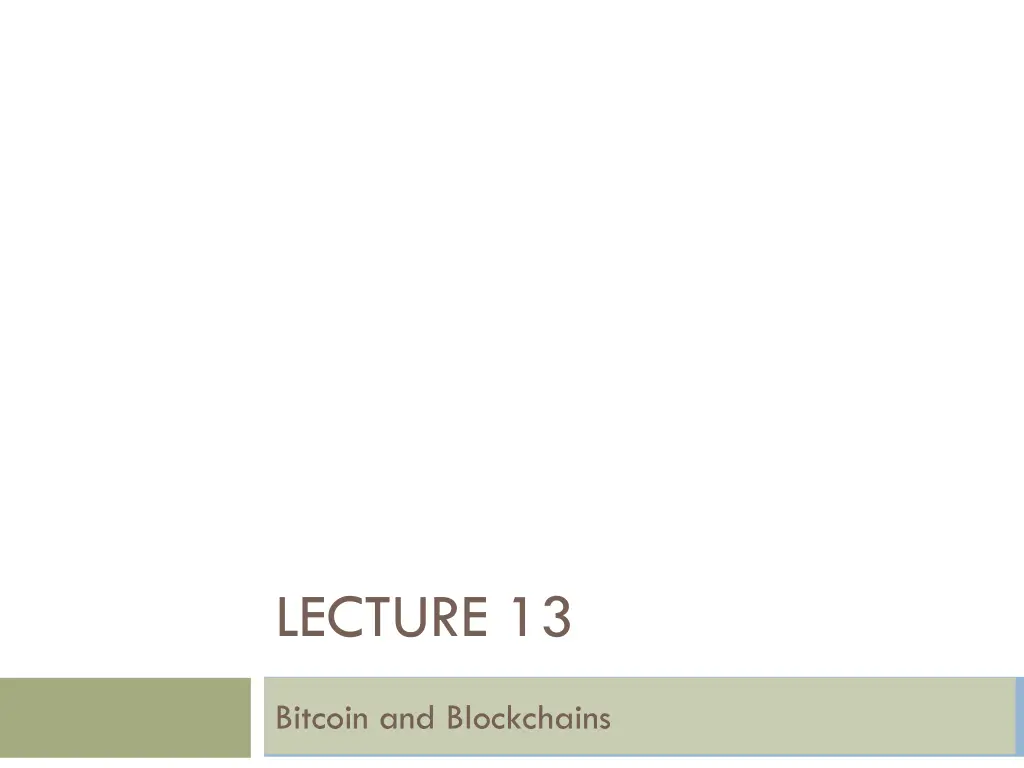
Understanding Bitcoin, Cryptocurrency, and Blockchain Technology
Explore the fundamentals of Bitcoin, the rise of cryptocurrencies, the role of digital currency properties, and the importance of encryption in preventing theft within blockchain transactions. Delve into the creation of public ledgers, the complexities of transactions, and the challenges of maintaining a secure distributed system.
Uploaded on | 0 Views
Download Presentation

Please find below an Image/Link to download the presentation.
The content on the website is provided AS IS for your information and personal use only. It may not be sold, licensed, or shared on other websites without obtaining consent from the author. If you encounter any issues during the download, it is possible that the publisher has removed the file from their server.
You are allowed to download the files provided on this website for personal or commercial use, subject to the condition that they are used lawfully. All files are the property of their respective owners.
The content on the website is provided AS IS for your information and personal use only. It may not be sold, licensed, or shared on other websites without obtaining consent from the author.
E N D
Presentation Transcript
LECTURE 13 Bitcoin and Blockchains
Properties of Digital Currency 3 Say Bob pays for purchase with digital coins What properties must seller check about coins? Valid (i.e., not forged) Not already spent Owned by Bob (i.e., not stolen) How do shopping portals check these today? Rely on bank, Visa, Mastercard,
Eliminating Centralized Trust 4 Imagine public ledger of transactions Every transaction ( A paid $X to B ) in ledger Benefits: Any user cannot spend more money than earned How to achieve such a public ledger? Paxos log? Any user can propose transaction between any pair of users!
Encryption and Hashing 5 Every user has (public key, private key) pair Enc(m, pubu): can decrypt only with privu Sign(m, privu): can use pubu to verify signature Cryptographic hash function: Hard to infer value given hash(value)
Preventing Theft 6 Represent coin transfer from Alice to Bob as: T = pubBob, sign(hash(T ), privAlice) T is transaction via which Alice acquired this coin When Bob transfers coin to Charlie later: T = pubCharlie, sign(hash(T), privBob) Anyone can use pubBob from T to verify signature What would it take to spend another user s cash?
Transactions Note that the previous slide shows how transactions are crafted. The output of the transaction is the currency. The precision of the output of the transaction limits the extent to which the currency can be subdivided. Smallest unit is satoshi and 108 satoshis is one bitcoin. As seen in the previous slide, each output also consists of some indicator of the public key needed to redeem the currency.
Public Ledger 8 Distributed system comprising 1000s of nodes Broadcast transactions; valid if majority report No money stolen unless private key leaks How to identify majority? Majority of IP addrs? What can Mallory do if she controls majority? Export different views of ledger to different users Double spending! Sybil attack: Same user runs many nodes
Desired Properties of Ledger 9 Strongly consistent All users must see the same set of transactions Append-only Can only add transactions Cannot remove transactions
Bitcoin: Key Idea 10 Every node must do work to participate Called mining Essentially relates to solving a puzzle whoever solves it first is able to add its block after others have verified.
Structure of Bitcoin Ledger 11 Each miner picks a set of transactions for new block Links to previous block by including its hash Pick nonce for header
Bitcoin: Proof of work 12 The puzzle is : Find nonce such that hash (nonce || prev_hash || block data) < target i.e., hash has certain number of leading 0 s At any time, all nodes in race to identify nonce for next block Target set such that new block every 10 minutes Incentive for any node to participate?
13Coping with Forks prev: H( ) prev: H( ) prev: H( ) prev: H( ) prev: H( ) txn 8 txn 9 txn 5 txn 6 txn 7 prev: H( ) txn 6 Correct nodes accept longest chain (most difficult to break computationally) Older a block, the safer it is from being deleted Common practice: Transaction 6 blocks deep committed (no formal grounding).
Block confirmation Consensus is gradual so users must wait for transactions to be accepted. During a fork one of the branches will be eventually discarded after miners converge on the other. If the two branches include conflicting transactions , one may be included in the longest chain. However, if the other chain later surpasses, it may have to be revoked. Sometimes could result in double spending (although rare). If majority of miners follow default protocol, Bitcoin avoids these issues.
Randomized leader election 15 Each time a nonce is found: New leader elected for past epoch (~10 min) Leader decides which transactions comprise block Probability of a node selected as leader? Proportional to node s % of global hashing power Because more likely to solve the puzzle. Miners could get paid a part of the transaction fees (transactions fees also eliminates flooding of small transactions).
16Scaling Bitcoin Scaling limitations 1 block = 1 MB max (~ 2000 transactions) 1 block every 10 mins 3-4 txns / sec Visa peak load comparison Typically 2,000 txns / sec Peak load in 2013: 47,000 txns / sec Joining requires full download of ledger High energy consumption
Impact of Bitcoin 17 Idea of public ledger (called blockhain) widely applicable Remove dependence on centralized trust Impact of using blockchain to create digital currency Various new directions have emerged (but we won t cover).






















